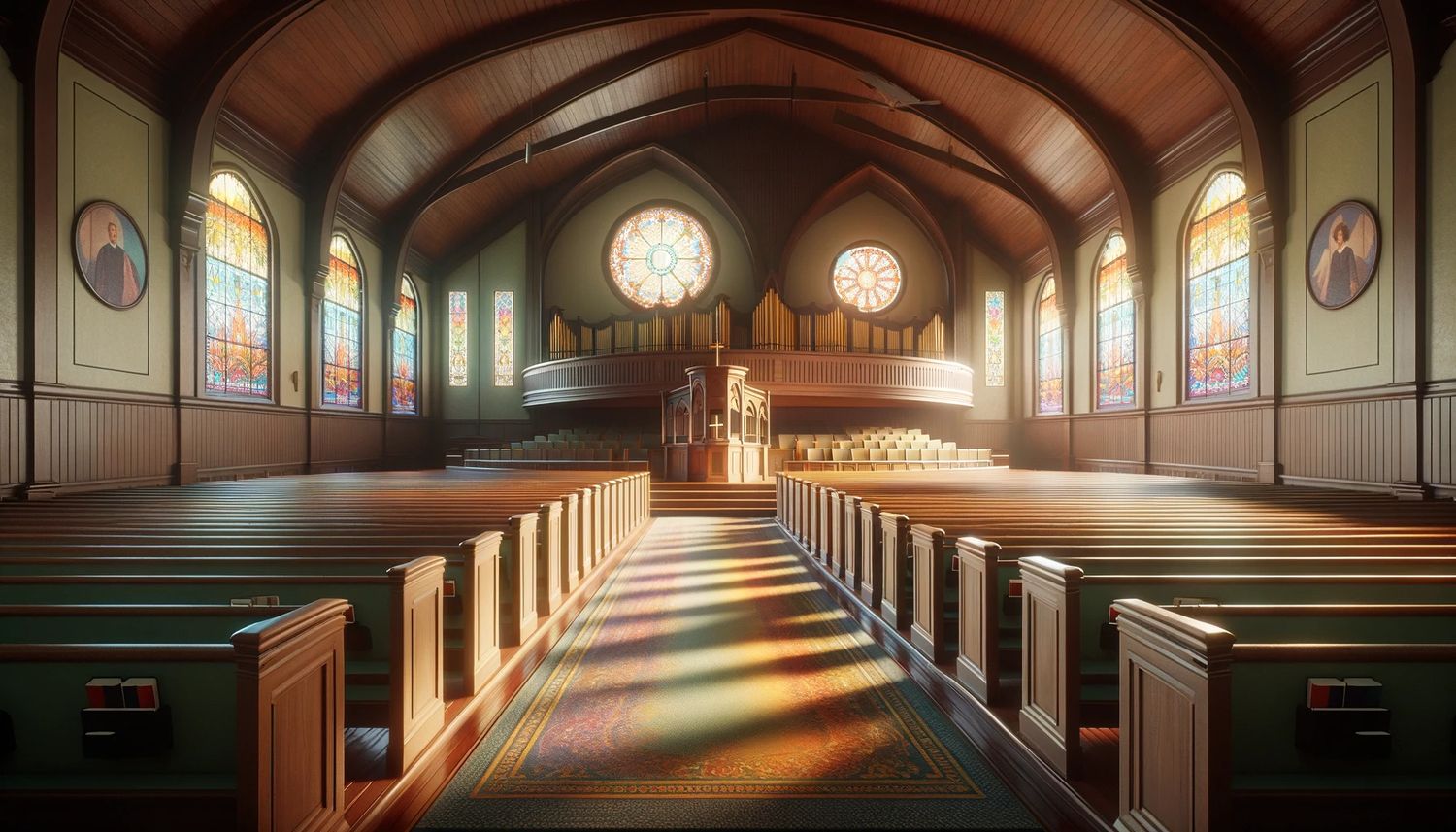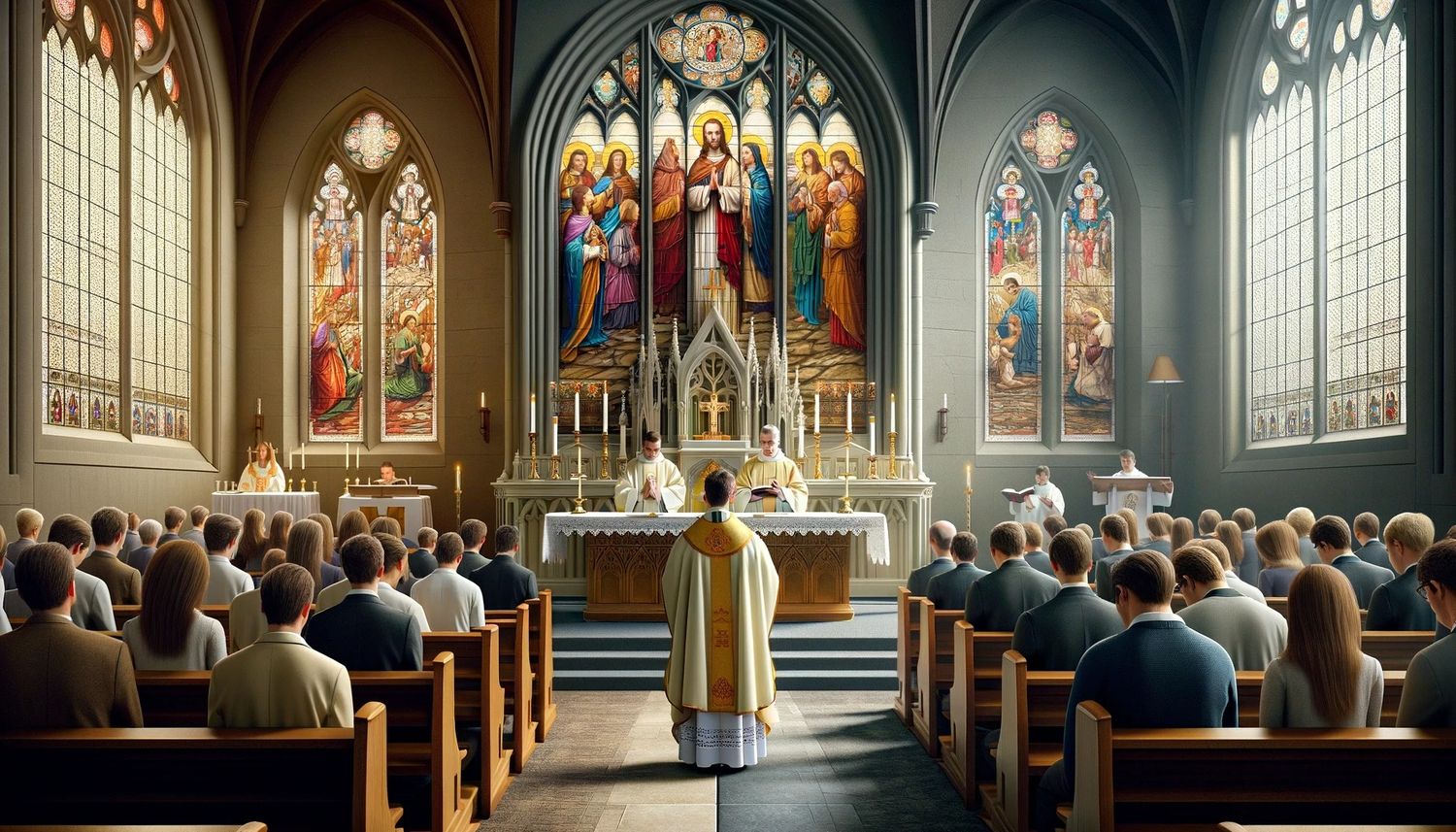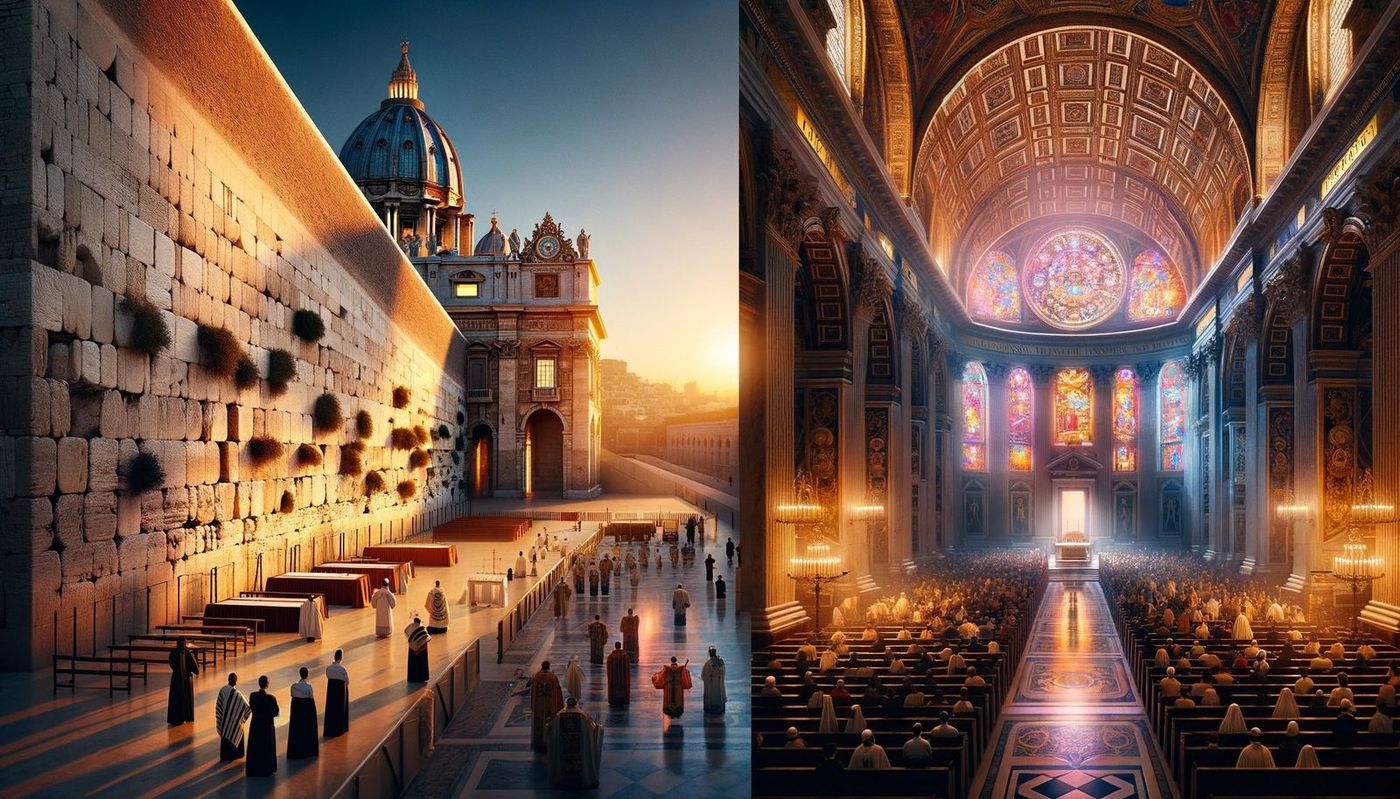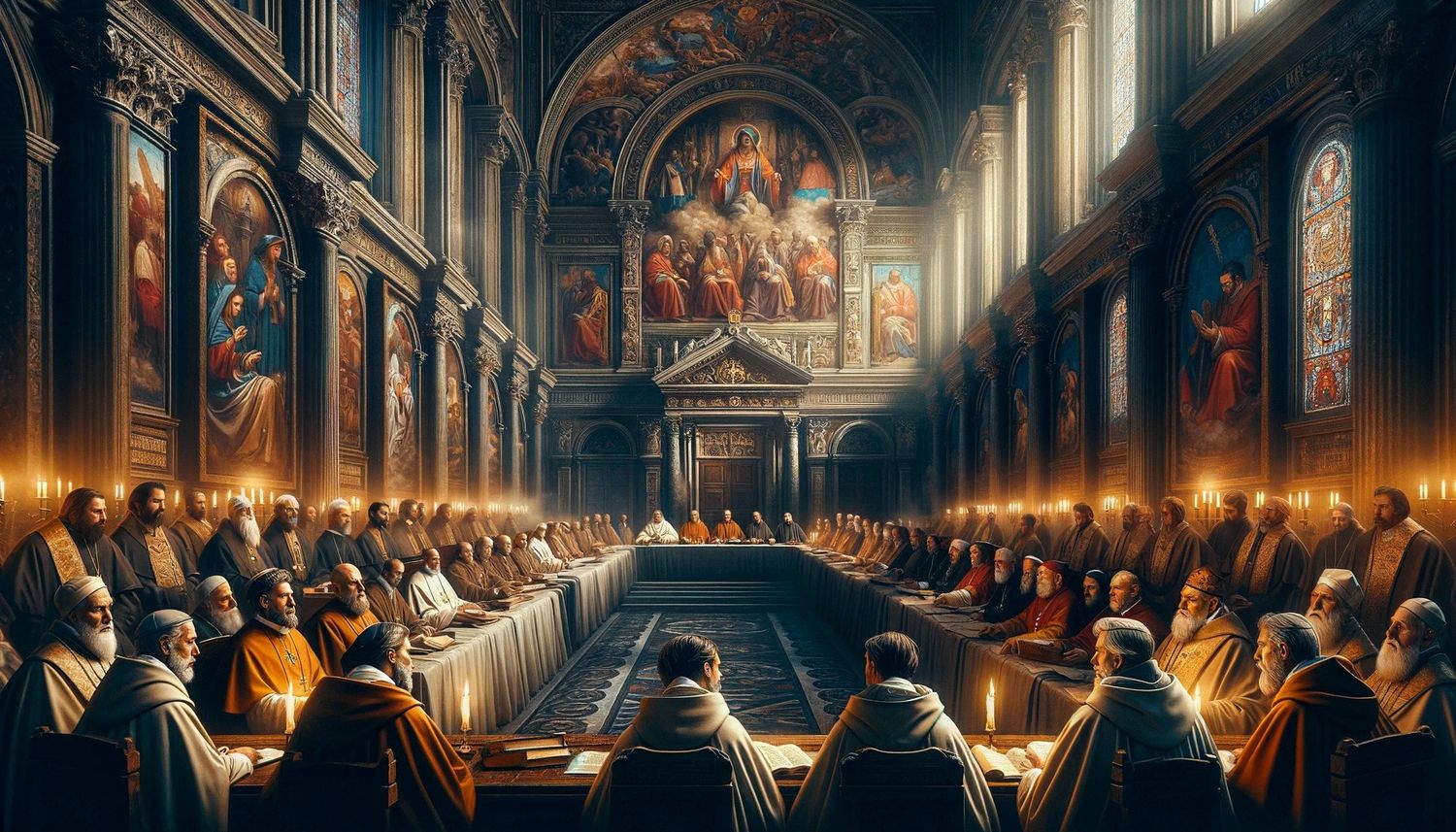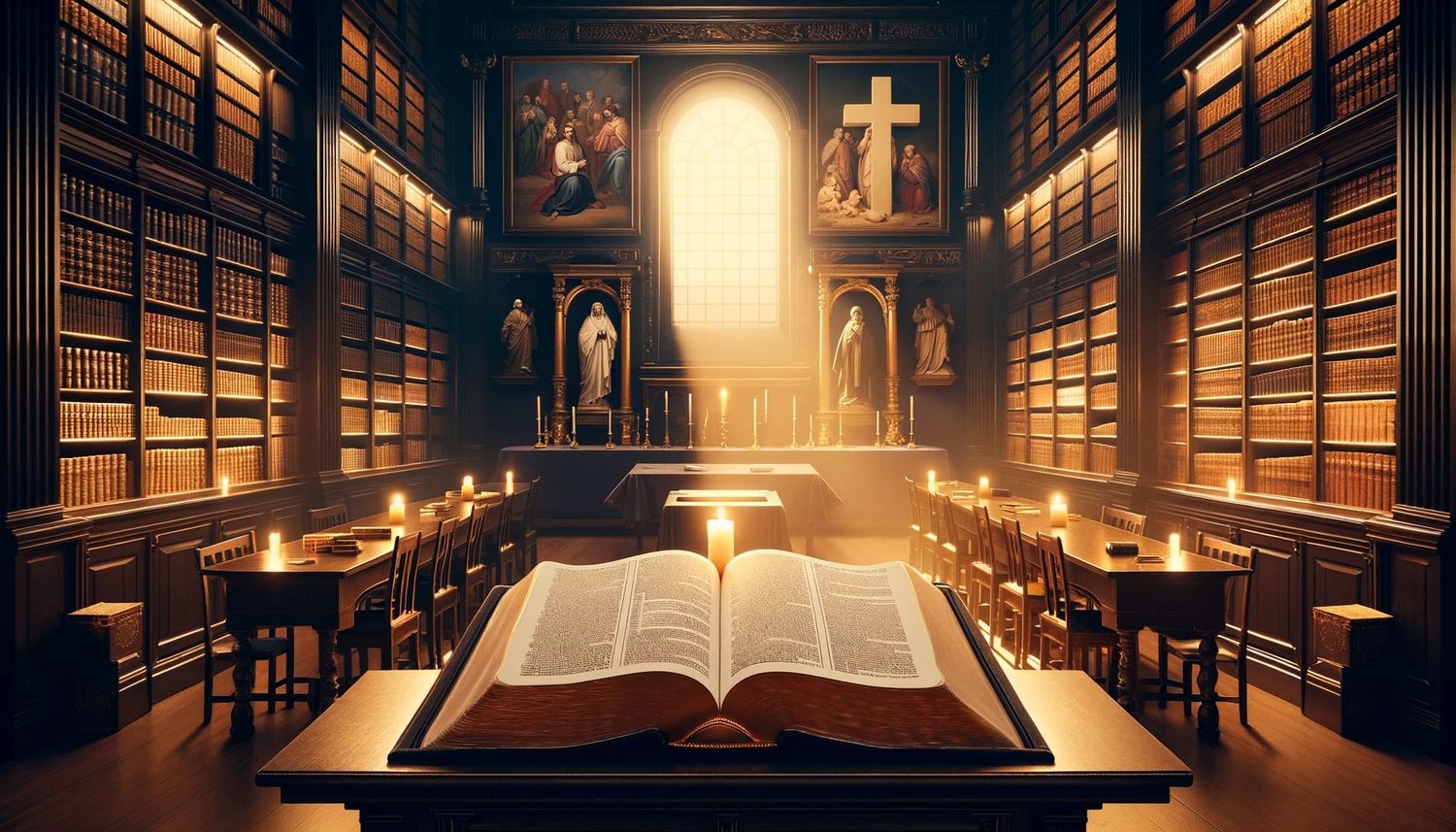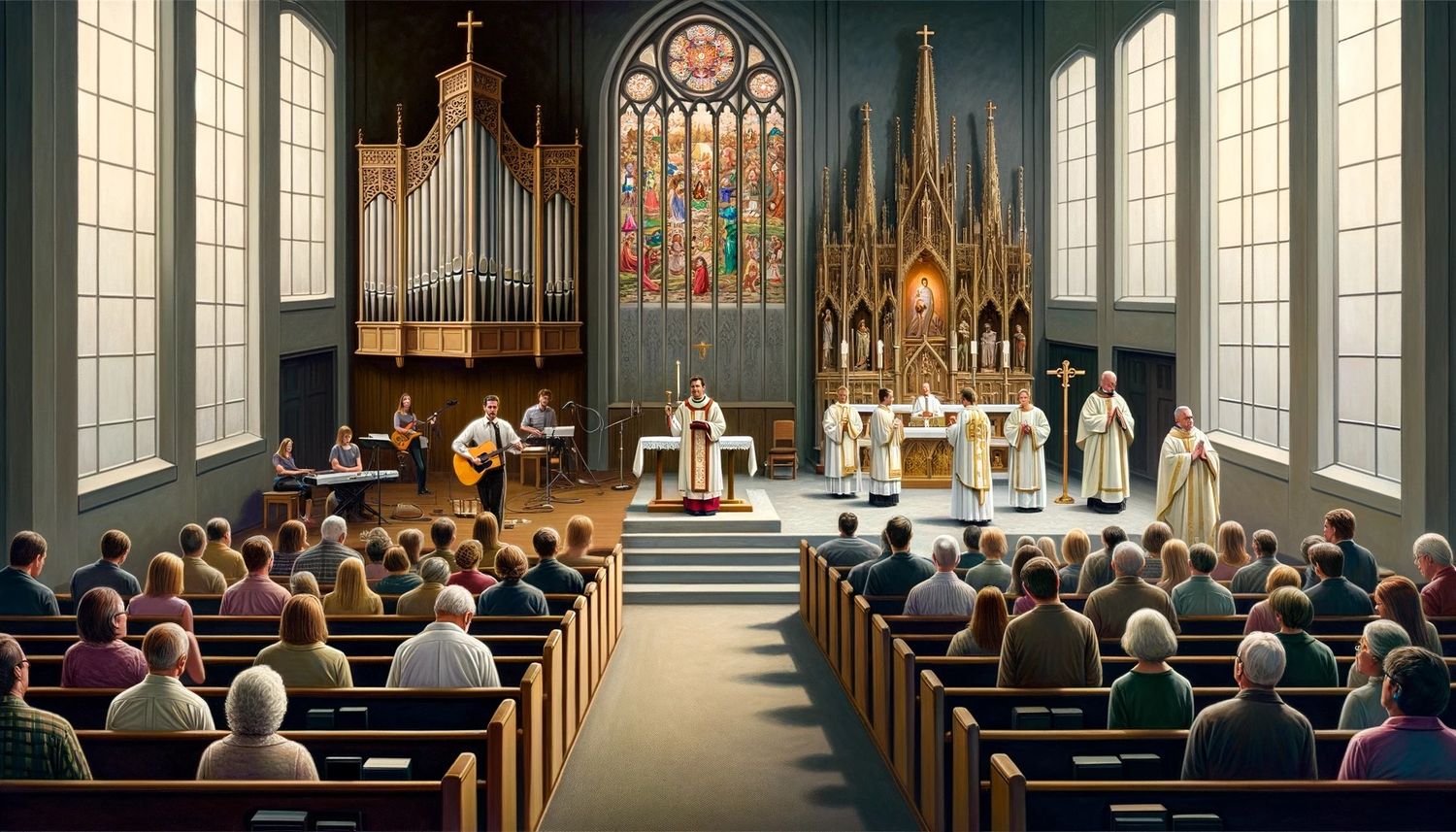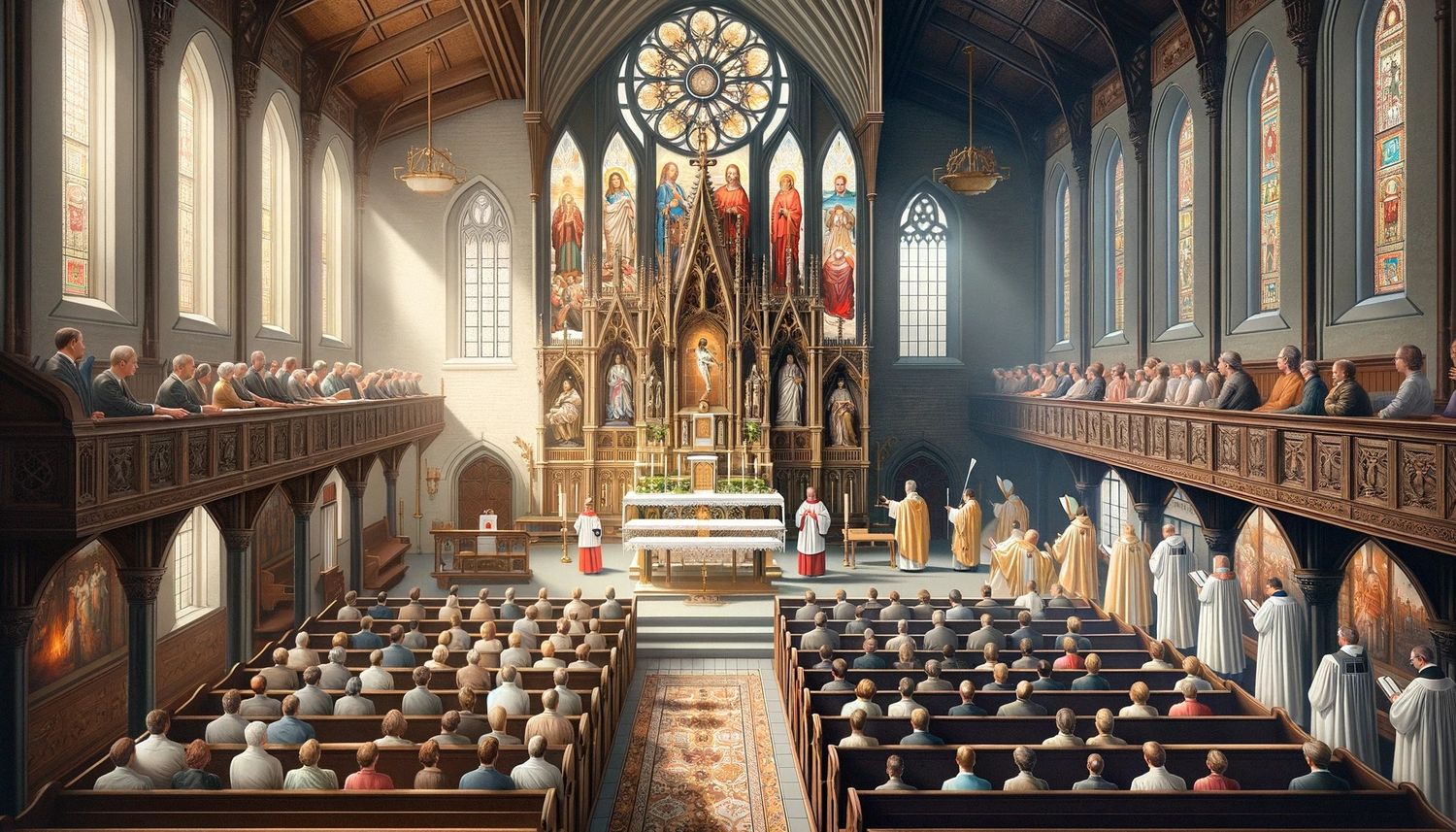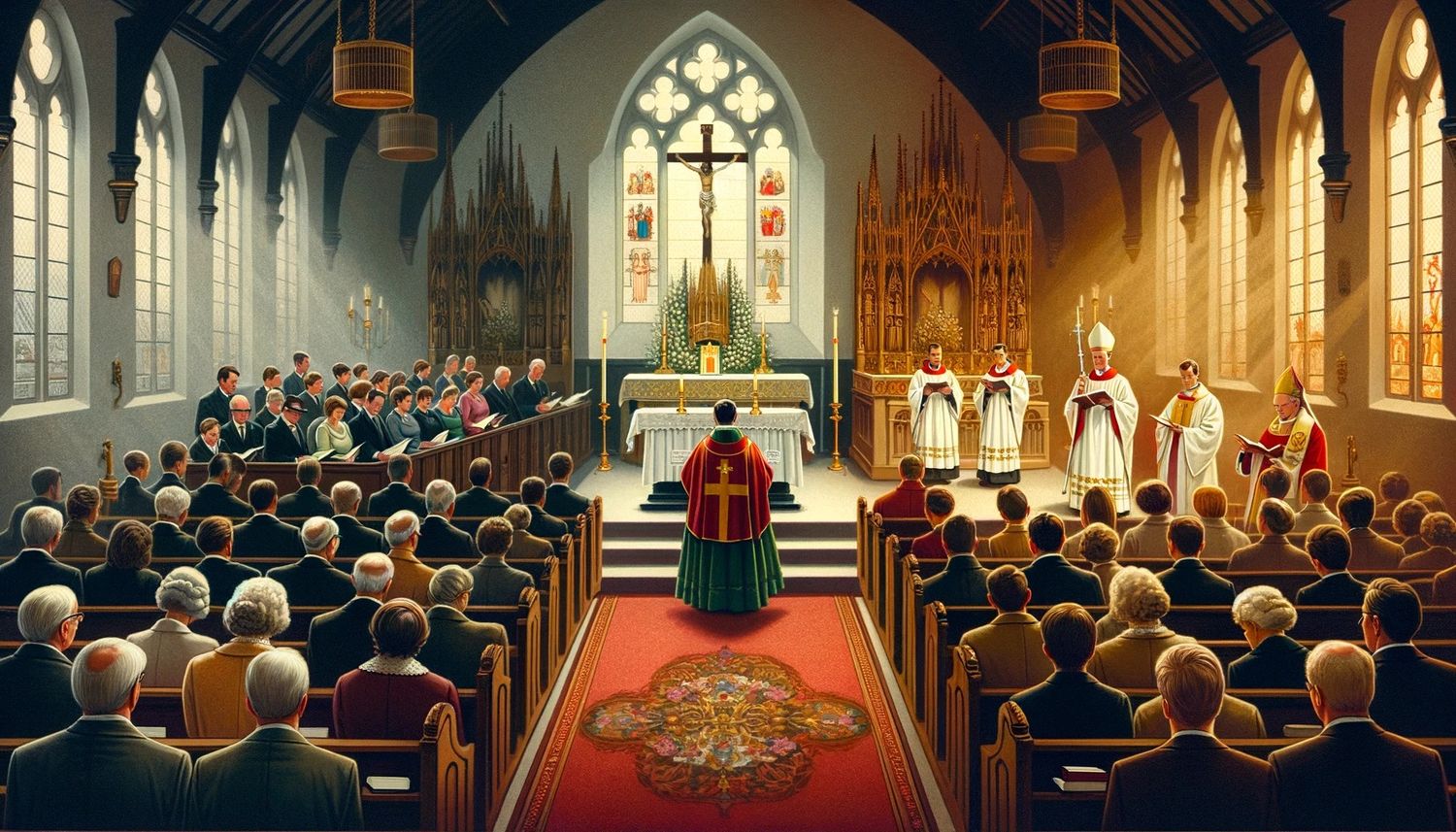Home>Theology and Spirituality>How Is Eastern Orthodox Christianity Different From Catholicism?
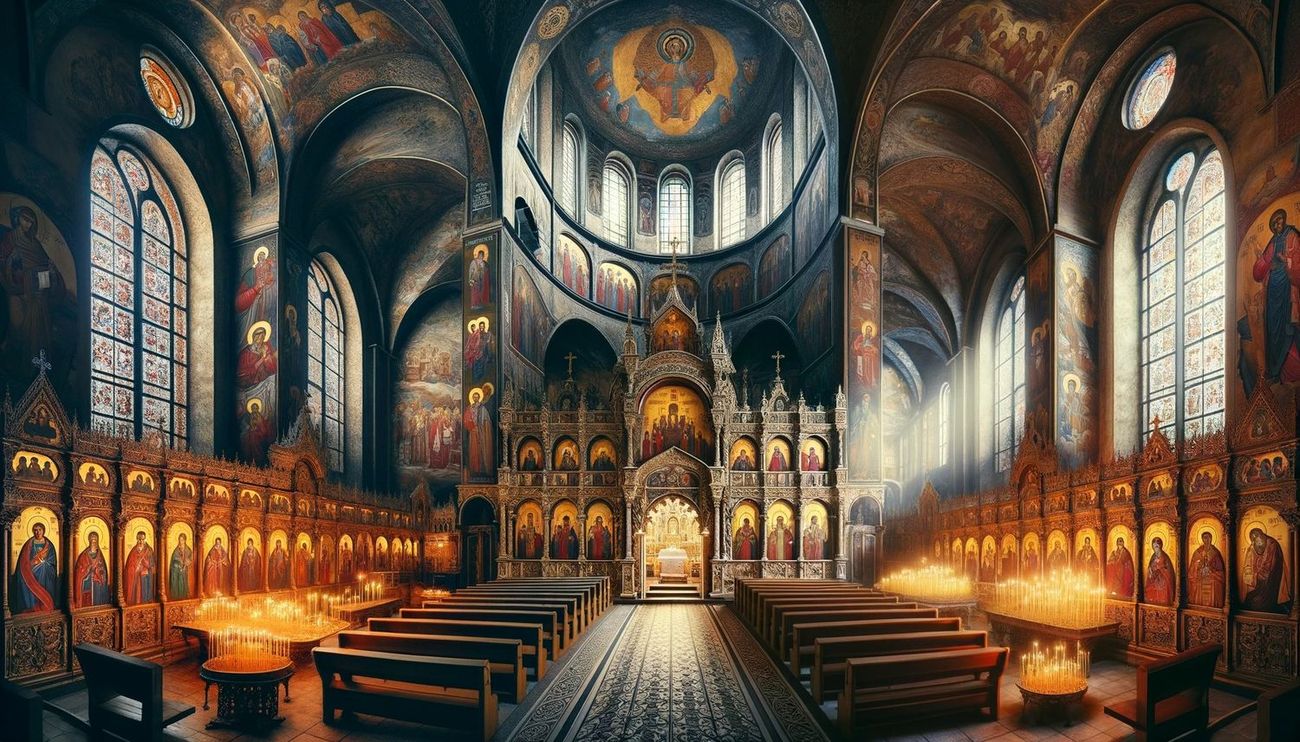

Theology and Spirituality
How Is Eastern Orthodox Christianity Different From Catholicism?
Published: February 18, 2024
Peter Smith, Editorial Director at Christian.net, combines deep insights into faith, politics, and culture to lead content creation that resonates widely. Awarded for his contributions to religious discourse, he previously headed a major organization for religious communicators, enhancing dialogue on faith's societal impacts.
Discover the key differences between Eastern Orthodox Christianity and Catholicism in terms of theology and spirituality. Explore the unique beliefs and practices that set these two branches of Christianity apart.
(Many of the links in this article redirect to a specific reviewed product. Your purchase of these products through affiliate links helps to generate commission for Christian.net, at no extra cost. Learn more)
Table of Contents
- Introduction
- History of Eastern Orthodox Christianity
- History of Catholicism
- Beliefs and Practices in Eastern Orthodox Christianity
- Beliefs and Practices in Catholicism
- Leadership and Structure in Eastern Orthodox Christianity
- Leadership and Structure in Catholicism
- Differences in Sacraments and Liturgy
- Views on Original Sin and Atonement
- Conclusion
Introduction
Eastern Orthodox Christianity and Catholicism are two major branches of Christianity, each with its own rich history, traditions, and beliefs. While they share a common foundation in the teachings of Jesus Christ, there are distinct differences that have evolved over centuries, shaping the way each faith is practiced and understood.
Understanding the differences between Eastern Orthodox Christianity and Catholicism is essential for appreciating the diversity within Christianity and for fostering mutual respect and dialogue among believers. Both traditions have contributed significantly to the development of Christian theology, spirituality, and culture, and exploring their distinctions can provide valuable insights into the multifaceted nature of the Christian faith.
In this article, we will delve into the historical origins, core beliefs, practices, leadership structures, sacraments, liturgy, and theological perspectives that set Eastern Orthodox Christianity apart from Catholicism. By examining these key aspects, we aim to shed light on the unique characteristics of each tradition and the ways in which they have shaped the religious landscape of the world.
Read more: Differences Of Catholicism And Christianity
History of Eastern Orthodox Christianity
Eastern Orthodox Christianity traces its origins to the early Christian communities established in the eastern regions of the Roman Empire. The roots of this tradition can be found in the ancient sees of Jerusalem, Antioch, Alexandria, and Constantinople, which played pivotal roles in the spread of Christianity and the development of its theological thought.
The Great Schism of 1054 marked a significant turning point in the history of Eastern Orthodox Christianity. This event led to the formal division between the Eastern Orthodox Church and the Roman Catholic Church, resulting from a combination of theological, cultural, and political differences. The Eastern Orthodox Church maintained its distinct identity, emphasizing its adherence to the teachings of the early Church Fathers and the preservation of ancient liturgical practices.
Throughout its history, Eastern Orthodox Christianity has been deeply intertwined with the political and social dynamics of the regions where it flourished. The Byzantine Empire, with its capital in Constantinople, served as a major center for the propagation of Eastern Orthodox Christianity, influencing the development of its theological doctrines and ecclesiastical structures.
The Eastern Orthodox Church weathered various challenges, including periods of persecution, internal theological debates, and encounters with other religious traditions. Despite these obstacles, the tradition persevered and continued to exert a profound influence on the spiritual and cultural life of the Eastern Christian world.
The history of Eastern Orthodox Christianity is characterized by a commitment to preserving the apostolic faith, maintaining the integrity of its liturgical heritage, and fostering a sense of communal spirituality among its adherents. This rich historical tapestry has contributed to the distinctiveness of Eastern Orthodox Christianity and continues to shape its identity in the contemporary era.
In summary, the history of Eastern Orthodox Christianity is marked by its deep roots in the early Christian communities, the enduring impact of the Great Schism, its close association with political entities, and its resilience in the face of historical challenges. These historical dynamics have played a crucial role in shaping the unique ethos and trajectory of Eastern Orthodox Christianity as a major branch of the Christian faith.
History of Catholicism
Catholicism, as a major branch of Christianity, has a rich and multifaceted history that spans over two millennia. Its origins can be traced back to the teachings of Jesus Christ and the early Christian communities in the Mediterranean region. The term "Catholic" itself derives from the Greek word "katholikos," meaning "universal," reflecting the tradition's aspiration to encompass a comprehensive and inclusive faith community.
The early centuries of Catholicism were marked by the spread of Christianity throughout the Roman Empire, despite periods of persecution and opposition. The emergence of influential figures such as Saint Peter and Saint Paul, along with the establishment of the episcopal hierarchy and the formulation of key doctrinal beliefs, laid the groundwork for the development of the Catholic Church as an enduring institution.
One of the pivotal events in the history of Catholicism was the Edict of Milan in 313 AD, which granted official toleration of Christianity within the Roman Empire. This marked a significant turning point, leading to the eventual recognition of Christianity as the empire's state religion under Emperor Theodosius I in 380 AD.
The influence of Catholicism continued to expand, shaping the cultural, intellectual, and spiritual landscape of Europe and beyond. The rise of monasticism, the scholastic tradition, and the flourishing of Christian art and architecture all contributed to the rich tapestry of Catholic history.
The Great Schism of 1054 resulted in the formal division between the Eastern Orthodox Church and the Roman Catholic Church, leading to distinct theological and ecclesiastical trajectories. Despite this schism, Catholicism endured as a dominant force in Western Christendom, navigating through periods of reform, expansion, and interaction with diverse cultures and civilizations.
The Protestant Reformation in the 16th century brought about significant challenges and transformations within Catholicism, prompting internal renewal and the Council of Trent, which addressed doctrinal and disciplinary issues. The missionary endeavors of Catholic religious orders, the exploration of the New World, and the engagement with the challenges of modernity further shaped the historical trajectory of Catholicism.
In summary, the history of Catholicism is characterized by its enduring presence in the development of Western civilization, its engagement with theological and social challenges, and its global expansion as a universal faith. The multifaceted historical journey of Catholicism has left an indelible mark on the religious, cultural, and intellectual heritage of humanity.
Beliefs and Practices in Eastern Orthodox Christianity
Eastern Orthodox Christianity encompasses a rich tapestry of beliefs and practices that have been shaped by centuries of theological reflection, liturgical expression, and spiritual devotion. At the core of Eastern Orthodox belief is a deep reverence for the teachings of the early Church Fathers and the preservation of apostolic tradition. This commitment to continuity with the early Christian community underscores the Orthodox understanding of faith and practice.
Central to Eastern Orthodox spirituality is the concept of theosis, or deification, which emphasizes the transformative journey of believers toward union with God. This process of divinization is seen as the ultimate purpose of human existence, and it informs the Orthodox approach to salvation and spiritual growth. Theosis is not merely a theoretical concept but a lived reality, guiding the faithful in their pursuit of holiness and communion with the divine.
The veneration of icons holds a prominent place in Eastern Orthodox spirituality, reflecting the belief in the incarnation of Christ and the sacramental nature of matter. Icons are regarded as windows to the heavenly realm, serving as aids to prayer and contemplation. The veneration of saints and their relics is also an integral aspect of Orthodox piety, emphasizing the communion of the living and the departed within the mystical body of Christ.
The liturgical life of the Eastern Orthodox Church is characterized by its solemnity, beauty, and time-honored rituals. The celebration of the Eucharist, or Divine Liturgy, occupies a central position in Orthodox worship, embodying the belief in the real presence of Christ in the consecrated elements. The cycle of feasts and fasts, the use of incense and chant, and the intricate symbolism woven into the liturgical calendar all contribute to the immersive and transcendent nature of Orthodox worship.
The sacramental life of Eastern Orthodox Christianity encompasses various rites, including baptism, chrismation, confession, marriage, holy orders, and the anointing of the sick. These sacraments are viewed as tangible means through which God's grace is imparted to the faithful, nurturing their spiritual journey and strengthening their bond with the Church.
In summary, the beliefs and practices of Eastern Orthodox Christianity reflect a profound commitment to the ancient traditions of the Christian faith, the pursuit of theosis, the sacramental life of the Church, and the rich tapestry of liturgical worship. These elements collectively shape the spiritual identity of Eastern Orthodox believers and contribute to the enduring vitality of this ancient Christian tradition.
Beliefs and Practices in Catholicism
Catholicism, as a major branch of Christianity, encompasses a rich tapestry of beliefs and practices that have evolved over centuries, shaping the spiritual identity of millions of adherents worldwide. At the heart of Catholic belief is a deep reverence for sacred tradition, Scripture, and the authoritative teachings of the Magisterium, the Church's teaching authority. This commitment to the continuity of faith and practice with the early Christian community underscores the Catholic understanding of divine revelation and the living tradition.
Central to Catholic spirituality is the sacramental life of the Church, which emphasizes the tangible encounters with God's grace through the seven sacraments: baptism, confirmation, the Eucharist, reconciliation, anointing of the sick, holy orders, and matrimony. These sacraments are regarded as efficacious signs of God's presence and transformative power, nurturing the spiritual growth and communal bond of the faithful.
The veneration of saints and the Blessed Virgin Mary holds a prominent place in Catholic piety, reflecting the belief in the communion of saints and the intercessory role of the saints in the life of the Church. Devotional practices such as the rosary, novenas, and pilgrimages to sacred sites are integral to Catholic spirituality, fostering a deep sense of connection with the heavenly realm and the communion of believers across time and space.
The liturgical life of the Catholic Church is characterized by its richness, diversity, and the celebration of the Eucharist as the "source and summit" of the Christian life. The liturgical calendar, with its cycle of feasts and seasons, provides a framework for the spiritual journey of the faithful, inviting them to enter into the mysteries of Christ's life, death, and resurrection through sacred rituals and communal prayer.
Catholic social teaching, rooted in the Gospel and the Church's moral tradition, underscores the commitment to justice, solidarity, and the dignity of every human person. This ethical framework informs the Church's engagement with pressing social issues, advocating for the rights of the poor, the marginalized, and the vulnerable, and promoting a culture of life and peace in a world marked by inequality and conflict.
In summary, the beliefs and practices of Catholicism reflect a profound commitment to sacred tradition, the sacramental life of the Church, the communion of saints, the richness of liturgical worship, and the ethical imperative of social justice. These elements collectively shape the spiritual identity of Catholic believers and contribute to the enduring vitality of this ancient and diverse Christian tradition.
Leadership and Structure in Eastern Orthodox Christianity
The leadership and structure of Eastern Orthodox Christianity are characterized by a rich tapestry of ecclesiastical hierarchy, canonical tradition, and synodal governance. At the apex of the hierarchical structure is the Ecumenical Patriarch, who holds a position of honor and spiritual significance within the Eastern Orthodox communion. The Ecumenical Patriarch serves as the spiritual leader of the Church of Constantinople and holds a primacy of honor among the autocephalous (self-governing) Orthodox churches.
Beneath the Ecumenical Patriarch are the heads of the various autocephalous churches, such as the Patriarchs of Alexandria, Antioch, Jerusalem, and the heads of the national churches, including the Church of Russia, the Church of Greece, and the Church of Serbia, among others. Each autocephalous church operates with a degree of independence in its internal affairs, including the election of bishops and the administration of ecclesiastical matters within its geographical jurisdiction.
The synodal structure of the Eastern Orthodox Church is characterized by the participation of bishops, clergy, and laity in decision-making processes, reflecting the conciliar nature of Orthodox ecclesiology. Ecumenical and regional councils play a crucial role in addressing theological, doctrinal, and disciplinary matters, fostering a sense of communal discernment and accountability within the Church.
The episcopal hierarchy, with bishops serving as the spiritual shepherds of dioceses and regions, forms the backbone of the Eastern Orthodox leadership structure. Bishops are ordained through the ancient apostolic succession, tracing their lineage back to the original apostles, and are entrusted with the pastoral care of the faithful, the administration of sacraments, and the preservation of doctrinal orthodoxy.
The monastic tradition also holds a revered place within Eastern Orthodox Christianity, with monasteries serving as centers of spiritual formation, prayer, and charitable work. Monastic communities are guided by abbots and abbesses, who oversee the monastic life and provide spiritual guidance to the monks and nuns under their care.
In summary, the leadership and structure of Eastern Orthodox Christianity are characterized by the primacy of the Ecumenical Patriarch, the autonomy of autocephalous churches, the synodal model of governance, the episcopal hierarchy, and the enduring influence of the monastic tradition. These elements collectively shape the ecclesiastical identity of Eastern Orthodox Christianity and contribute to its vibrant and diverse expression of the Christian faith.
Leadership and Structure in Catholicism
The leadership and structure of Catholicism are characterized by a hierarchical framework that reflects a blend of spiritual authority, canonical tradition, and global communion. At the summit of the hierarchical structure is the Bishop of Rome, who holds the title of the Pope and serves as the spiritual leader of the Catholic Church. The Pope, considered the successor of Saint Peter, is regarded as the Vicar of Christ on earth and holds primacy of jurisdiction over the entire Catholic Church.
Beneath the Pope are the College of Cardinals, who serve as advisors and electors of the new Pope. The College of Cardinals reflects the diversity of the global Church and plays a crucial role in the governance and administration of the Church, particularly during the vacancy of the papal office.
The episcopal hierarchy forms the foundation of the Catholic leadership structure, with bishops serving as the spiritual shepherds of dioceses and regions. Bishops are ordained through the apostolic succession, tracing their lineage back to the original apostles, and are entrusted with the pastoral care of the faithful, the administration of sacraments, and the preservation of doctrinal orthodoxy within their respective dioceses.
The College of Bishops, in union with the Pope, exercises the teaching authority of the Church, safeguarding the deposit of faith and contributing to the development of Catholic doctrine and moral teachings. Ecumenical and regional councils, along with synods and episcopal conferences, provide platforms for collective discernment and decision-making on matters of theological significance and pastoral concern.
The Roman Curia, the administrative apparatus of the Holy See, assists the Pope in the governance of the universal Church, overseeing various departments, tribunals, and councils responsible for matters such as doctrine, liturgy, evangelization, and social justice.
The religious orders and congregations, encompassing a diverse array of charisms and apostolates, contribute to the vitality of Catholic leadership and ministry, engaging in educational, charitable, and missionary endeavors across the globe.
In summary, the leadership and structure of Catholicism are characterized by the primacy of the Pope, the College of Cardinals, the episcopal hierarchy, the collegiality of bishops, the Roman Curia, and the dynamic contributions of religious orders and congregations. These elements collectively shape the ecclesiastical identity of Catholicism and contribute to its global presence as a vibrant and diverse expression of the Christian faith.
Differences in Sacraments and Liturgy
The differences in sacraments and liturgy between Eastern Orthodox Christianity and Catholicism reflect distinct theological emphases and liturgical expressions that have evolved over centuries within each tradition.
In Eastern Orthodox Christianity, the sacraments, often referred to as mysteries, are regarded as sacred rites through which the grace of God is conveyed to the faithful. The seven sacraments, including baptism, chrismation, the Eucharist, confession, marriage, holy orders, and the anointing of the sick, are celebrated with a profound sense of reverence and continuity with the early Church. The liturgical life of the Eastern Orthodox Church is characterized by its solemnity, beauty, and intricate symbolism, drawing from the rich heritage of Byzantine liturgical tradition. The Divine Liturgy, the central act of worship, is marked by its elaborate rituals, the use of sacred chant, and the veneration of icons, creating a transcendent and immersive experience for the worshiping community.
In Catholicism, the sacraments are central to the life of the Church, serving as visible signs of God's grace and presence. The seven sacraments, which include baptism, confirmation, the Eucharist, reconciliation, anointing of the sick, holy orders, and matrimony, are celebrated with reverence and sacramental efficacy. The liturgical life of the Catholic Church is characterized by its diversity, richness, and the celebration of the Eucharist as the "source and summit" of the Christian life. The Roman Rite, along with various Eastern Catholic liturgical traditions, embodies the universality of Catholic worship, incorporating diverse forms of liturgical music, art, and ritual expressions that reflect the cultural and historical diversity of the global Church.
While both traditions share a common understanding of the sacraments as channels of divine grace, differences in liturgical language, ritual practices, and theological emphases contribute to the distinctive expressions of sacraments and liturgy in Eastern Orthodox Christianity and Catholicism. These differences reflect the unique spiritual and cultural identities of each tradition, enriching the tapestry of Christian worship and spirituality.
In summary, the differences in sacraments and liturgy between Eastern Orthodox Christianity and Catholicism underscore the diverse expressions of sacramental theology and liturgical worship within the broader Christian tradition. These differences reflect the distinct spiritual and cultural identities of each tradition, contributing to the richness and diversity of Christian worship and sacramental life.
Views on Original Sin and Atonement
In Eastern Orthodox Christianity, the understanding of original sin and atonement is deeply rooted in the theological framework of ancestral sin and the transformative journey of theosis. The concept of original sin is approached from the perspective of ancestral solidarity, emphasizing that all humanity shares in the consequences of Adam and Eve's disobedience, rather than bearing personal guilt for their sin. This view underscores the inherited mortality and inclination towards sin, known as ancestral sin, which permeates the human condition. The Orthodox tradition maintains that while humanity bears the consequences of ancestral sin, the emphasis is on the healing and restoration of the human person through the redemptive work of Christ.
Atonement in Eastern Orthodox Christianity is understood as the process of divinization, wherein Christ's incarnation, life, death, and resurrection bring about the restoration of humanity's communion with God. The emphasis is on the transformative power of Christ's redemptive work, which enables believers to participate in the divine nature and overcome the effects of ancestral sin. Theosis, or deification, is central to the Orthodox understanding of atonement, highlighting the union of humanity with the divine through the grace of God. This transformative journey involves the purification of the passions, the illumination of the mind, and the union of the human will with the will of God, leading to the restoration of the image and likeness of God in the human person.
In Catholicism, the doctrine of original sin is articulated in terms of the inherited state of deprivation of original holiness and justice, resulting from the disobedience of Adam and Eve. This understanding emphasizes the transmission of original sin from generation to generation, highlighting the need for redemption and spiritual regeneration. The Catholic tradition affirms the doctrine of the Immaculate Conception, which holds that the Virgin Mary was preserved from original sin from the moment of her conception, in anticipation of her role as the mother of Christ.
Atonement in Catholicism is viewed through the lens of Christ's sacrificial death on the cross, which is understood as the definitive act of reconciliation between God and humanity. The redemptive work of Christ is seen as atoning for the sins of humanity, offering salvation and the promise of eternal life. The sacramental life of the Church, particularly the Eucharist, is central to the Catholic understanding of atonement, providing believers with the means to participate in the paschal mystery of Christ's death and resurrection, and to receive the grace of reconciliation and spiritual nourishment.
In summary, the views on original sin and atonement in Eastern Orthodox Christianity and Catholicism reflect distinct theological emphases and soteriological frameworks, each contributing to the rich tapestry of Christian understanding and spiritual practice.
Conclusion
In conclusion, the comparison of Eastern Orthodox Christianity and Catholicism reveals the rich tapestry of theological, liturgical, and ecclesiastical differences that have shaped these two major branches of the Christian faith. The historical trajectories, beliefs, practices, leadership structures, sacraments, and views on original sin and atonement highlight the diverse expressions of Christian spirituality and the enduring contributions of each tradition to the global Christian heritage.
Eastern Orthodox Christianity, with its deep roots in the early Christian communities, its emphasis on theosis, the veneration of icons, and the rich Byzantine liturgical tradition, embodies a spiritual ethos characterized by continuity with the ancient Church and a profound sense of communal spirituality. The synodal governance, the primacy of the Ecumenical Patriarch, and the enduring influence of the monastic tradition contribute to the distinctive identity of Eastern Orthodox Christianity as a vibrant and diverse expression of the Christian faith.
Catholicism, with its expansive historical journey, its sacramental richness, the veneration of saints, and the global diversity of liturgical traditions, reflects a universal and inclusive spiritual identity that has left an indelible mark on the religious, cultural, and intellectual heritage of humanity. The hierarchical structure, the primacy of the Pope, the collegiality of bishops, and the dynamic contributions of religious orders and congregations underscore the global presence and diverse expressions of Catholicism as a major force within the Christian tradition.
The differences between Eastern Orthodox Christianity and Catholicism, while reflective of distinct theological emphases and historical developments, serve as a testament to the multifaceted nature of the Christian faith. These differences, rather than being points of division, offer opportunities for mutual understanding, dialogue, and the enrichment of the broader Christian community. By appreciating the unique contributions of each tradition and fostering a spirit of respect and cooperation, believers can cultivate a deeper sense of unity within the diverse tapestry of Christianity.
Ultimately, the comparison of Eastern Orthodox Christianity and Catholicism invites us to embrace the richness of Christian diversity, to engage in meaningful conversations that bridge historical and theological divides, and to celebrate the enduring legacy of faith, spirituality, and cultural heritage that continues to inspire and shape the lives of millions of believers around the world.

